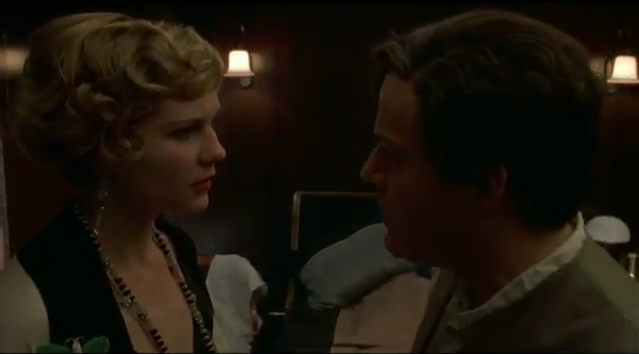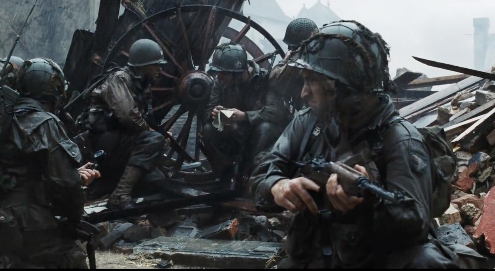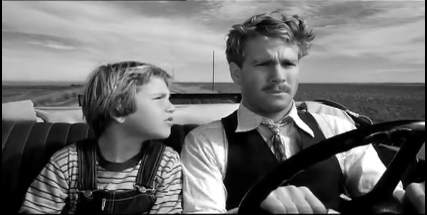
THE CAT’S MEOW (2001, Bogdanovich)
I really like this underrated film from Peter Bogdanovich, which seems to have slipped through the cracks since its release. While I believe its a wonderfully crafted and engaging film, I have to admit I’m biased because I love this whole era, and particularly the work of Chaplin, who’s a main character in it. This movie has a really great cast, especially the fantastic Edward Herrmann, who kills (in more ways than one) as W.R. Hearst.
The Cat’s Meow is based on rumors and speculation surrounding the very suspicious occurrences aboard W.R. Heart’s yacht in 1924 that may or may not have lead to the death of film mogul Thomas Ince (probably more ‘may’ than ‘may not.”) The leading theory is that Hearst was jealous of Chaplin’s affair with his girlfriend Marion Davies, and accidentally shot Ince when meaning to kill Charlie. You can read more about the mystery here, scroll down to “Murder and Natural Death debate.”
Today’s youtube clip not only shows Marion Davies (Kristen Dunst) and Charlie Chaplin (Eddie Izzard) in a really beautifully directed scene/shot, but also illuminates some really interesting aspects of this film as it’s a movie clip within the documentary “By Bogdanovich,” which includes a disconcertingly-not-so-animated, yet always interesting, Bogdanovich pontificating on his work. I love how he can just as easily claim credit for what he knows he’s done well as give kudos where kudos are due while admitting his own short-comings (eg, finding the ending of The Cat’s Meow).
Peter Bogdanovich channels Orson Welles
I know I said no one can block these oners like Welles, but, wow, P.B. sure is giving him a run for his money with this scene – it’s organic, flowing, natural and intense.
Today’s shot from The Cat’s Meow begins at 5:15 – but why not watch the whole excerpt from the documentary? It starts with The-Ascotted-One talking about his work in television, which I found very engaging.


dave C
I always learn so much from what you post. My only point of reference is theater where we can take rehearsal time to carefully plot out the blocking. Notice I said we, cuz I like to have input from the cast. It would seem that so much more of the weight of blocking falls on the film director’s shoulders because of the time element. Is that true? Is there any room for cast input on blocking? It must demand a very strong capacity for the director to visualize it all…
jsbfilm
I really love your theater analogies, Dave. Yes, time pressure is huge, but the actor’s input, I find, can be vital and even speed things up. But sometimes it can be the opposite, too. (Reminds me of Hitchcock’s infamous quip in response to an actor’s query of what his motivation was: “Your paycheck.”) There are 2 schools, though – those who, like Hitchcock, have it meticulously planned in advance and don’t want to discuss but want the actor to make it work, whatever the director gives them, and those who find it on the set with the actor’s input. When I plan meticulously, I really like to get the actors’ input nonetheless, but since I have an acting background, I think I have a good instinct in motivating blocking and it usually works. But actors always surprise you – and that’s what they’re there for!
jeremy Cole
Fun scene to pick apart, John. Camera-wise, it’s a good example of making one of those “two people talking in a room scenes” energetic.
The thing that unravels it for me is a question of Dunst’s motivation. I don’t know the movie so don’t have all the context, but maybe that brings up an interesting point… shouldn’t you be able to sense that there IS a motivation/subtext even if you don’t know what it is?
For Izzard, the blocking feels like it fits/grows out of the motivations pretty well. For him you might call it, “get her on that bed.” He pushes, cajoles, pursues, takes a hit, blocks the door, finally applies gentle pressure and kisses her… That part seems to work. Her motivations are less clear to me “Get him to convince you?” “Test his love?” Is she trying to get out that door or trying to get him to stop her? Did she come in with the article to end a dangerous flirtation with Charlie or to fan the flames? It doesn’t seem like she (Dunst) knows, so she can’t really find a position to listen and react to Izzard from. In the end Dunst’s part feels to me like a lot of tromping around and well read lines delivered on cue without any objective.
To answer my own question, I think you should be able to sense the motivation/subtext of a scene without context. It should have that kind of authentic life of its own, even if you’re not privy to it.
My 2 cents…
jsbfilm
Excellent posting, Jeremy – thanks. But weird! Every single beat of Dunst’s blocking I feel is perfectly committed to and motivated… save one, which I think is okay, but not perfect, 6:25 (her near U turn).
Now, in terms of being an actress with tremendous abilities with subtext & colors, I will grant you that – she’s not one of those. (Though I find her very likeable.) Her perf here is pretty single layer. But I don’t think that has anything to do with whether or not she’s fully selling her blocking in this scene, which I think she does. (She does, in every instance, want to avoid this confrontation with him.)
Izzard is a much more nuanced actor (if perhaps not as smooth sometimes), agreed. But the scene’s also written that she is the angry/scorned one and he is the pleading convincer – and I think it’s easier to play layers with his part as written in this scene than for her. Though I think a more nuanced actor in her role could have surely brought out more colors. You are right.
Jeremy Cole
We’re mixin’ it up. I love it!
All true, and that extra layer in the performance is what I was getting at. Text vs. subtext. Blocking is probably a funny if not backward way of getting into questions of objectives in a performance but in studying the blocking of the scene I couldn’t help seeing symptoms of an underlying problem.
Kicking the footrest on the barcalounger up for full armchair directing mode now…
I buy that Dunst is committed and there are motivations for each physical move (after all, it seems like the primary consideration for the scene was to make a lively oner). Given that Izzard’s part in the scene is to thrust and Dunst’s part is to parry, she does a fine job of selling her performance. But I don’t think that’s her job here. The text says, “I want Willy, ” and her overt refusals back that up. But all of her actions – the subtext – says, “convince me that I should choose you.” Yet, she’s not really playing that subtext. She’s playing “I want Willy”.
Around 6:05 she talks about the girl Charlie got pregnant and left… and is he going to love Dunst’s character like he loved her? Then, “It’s all about you, Charlie…” and a justification of loving Willy. These aren’t things you say to someone you want to leave you alone. This is a negotiation about what their relationship is going to be, and as Paul Simon says, negotiations and love songs are one and the same…
So, here’s my point: Looking at her performance, I can’t see an indication of what she wants from that negotiation. Instead, it’s “what you just said makes me really frustrated,” so I tromp over here. Then, “what you just said makes me really angry,” so I hit you and tromp again, and finally, “what you just said melts me.” It’s like she has the memory of a flea. Where’s her compass?
In my humble opinion, it’s an actor’s job to ask herself questions about her character’s objectives in a scene like this where she’s about to knowingly stir the pot, and bring the answers into the subtext. It’s a director’s job to make sure the actor does.
Suppose Bogdanovich had told Izzard, “get her on that bed” and then whispered in Dunst’s ear, “castrate him.” Maybe she goes into that room tired of this guy poisoning what she’s got with Willy, threatening her security, twisting the knife with her emotions. She has power. She holds Charlie’s heart in the palm of her hand. So squeeze a little. Now we’ve marked North on her compass and by God, she’s heading north. She’s got an objective and Charlie’s pursuit becomes her obstacle, and only when he gets her on that bed has she lost.
Granted that may not be the right objective at all but for example’s sake I think it shows how, given the same script, any clear objective could turn the discrete reactions of “parry and tromp” into a performance with an overall shape and direction, right down to the subtleties of the blocking.
Now I have to put this damn thing in my Netflix queue, watch the whole movie then write a rebuttal to my own post 😉
jsbfilm
‘Suppose Bogdanovich had told Izzard, “get her on that bed” and then whispered in Dunst’s ear, “castrate him.”‘ That’s excellent! For all we know he did – I’m not sure I’ve ever seen this kind of range ever from Dunst. Bogdanovich does mention that they got their financing because of her involvement, basically.
Your break down reminds me of Coppola’s (you’re welcome) director’s book for Godfather, where he meticulously broke down every scene by dramatic beat, subtext, character arcs, theme, etc. A great reminder to be uber-vigilant of all the layers at work. Also, reminds me of what we were talking about in the Radiers scene with Marion and Beloch.
But watching this scene in context will be telling – what was that line from “The Bad and The Beautiful” when the exasperated director exclaims to the micro-managing mogul Kirk Douglas? Paraphrasing, “If I included every subtext and character nuance in every scene – the film would be unwatchable!” Douglas doesn’t believe him, fires him, directs it how he sees fit, and the film does end up being unwatchable.
Jeremy Cole
Alright, bud, it’s #1 in my Netflix queue. Thanks for another thought provoking post. You could be right. Maybe trying to shoehorn in too much. Either way, you’re exercising my addled brain!
jsbfilm
Let’s both rewatch and meet back here in a couple days. No, thank YOU for the brain exercise!
Adam Hulin
Many thanks for linking the clip from my doc.
I was thrilled that Peter was so eager to talk about THE CAT’S MEOW during the interview; you can tell he has a genuine fondness for both the film and the people involved.
jsbfilm
Sure thing – thanks for writing, Adam. I really enjoyed watching it. It’s so refreshing to have such a calm and unfettered conversation with a filmmaker about his work. They’re often so over blown. The detail and candor you got from Peter is really appreciated. I also really loved the long and pertinent clips that you included. Great job! (It’s also the only place I could find that argument scene on line.)
Adam Hulin
Thank you.
The interview was a pleasure to do. One of the reasons I chose the career retrospective format was to shine a light on his underappreciated films like SAINT JACK, THEY ALL LAUGHED, and THE CAT’S MEOW.
Jeremy Cole
Okay, kimosabe, movie watched. Within the context of the film I do find that the scene holds up better but I think that’s just borrowed energy, information and momentum from the surrounding material, which is valid but leaves room of improvement.
Perhaps getting so nit picky with this one scene I’m writing the history of the world on a pearl but sometimes that’s how necklaces are made…
Anyway, in my previous post I used a lot of words to say that I think the scene could’ve been made better with a bit more subtext. Not long moments dwelling on stuff, just a tweak here and there to shade things. After viewing I still feel the same. My humble opinion.
On another subject, the thing that really struck me on viewing this film is, “whose story is it?” We seem to switch between Chaplin, Davies and Hearst without ever really settling on a protagonist. Then throw in the narrative device of the west coast gossip columnist framing it all up for us and it starts to feel a little muddled.
jsbfilm
Oh, crap, I’m behind on my homework. I own this movie, so will watch asap and chime back in!